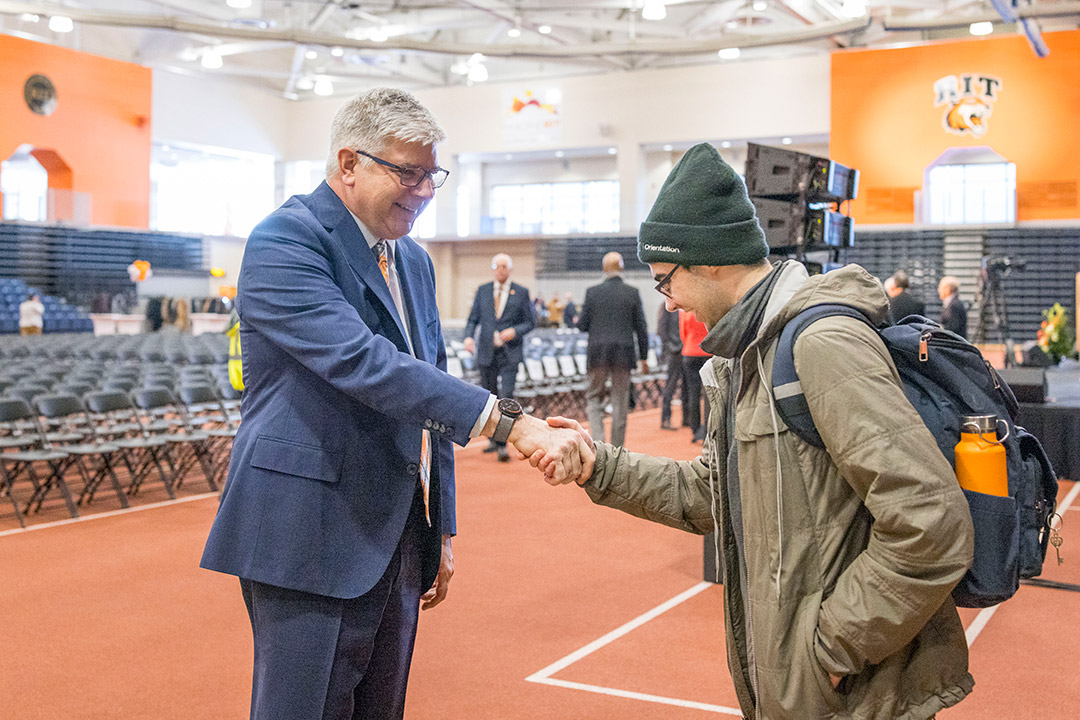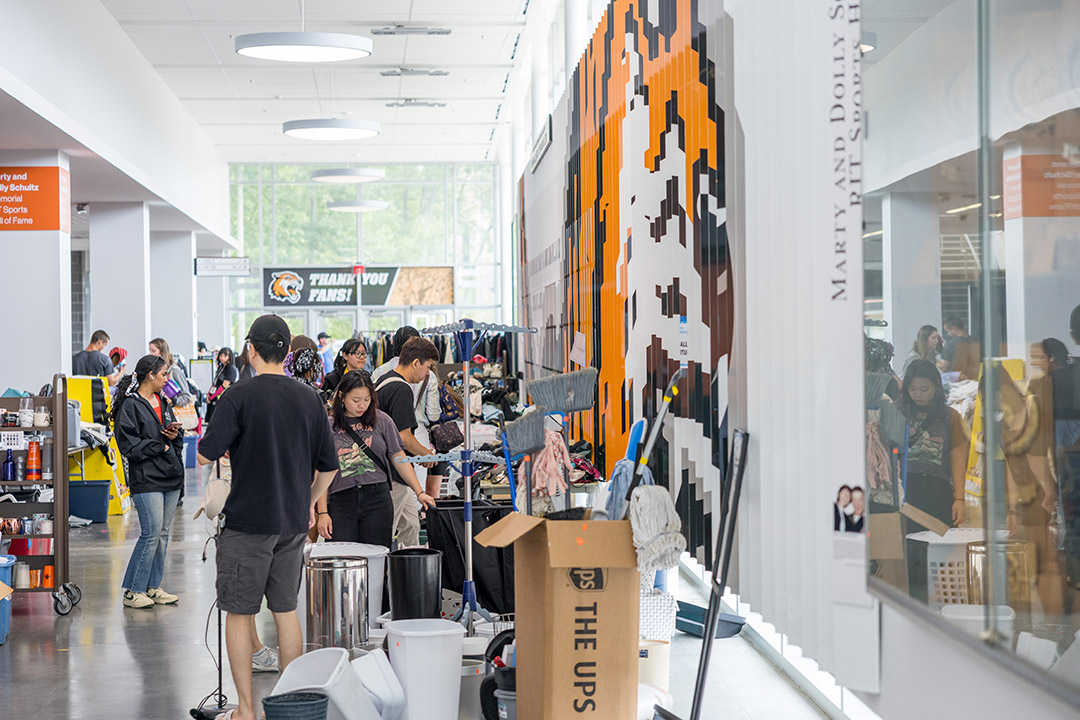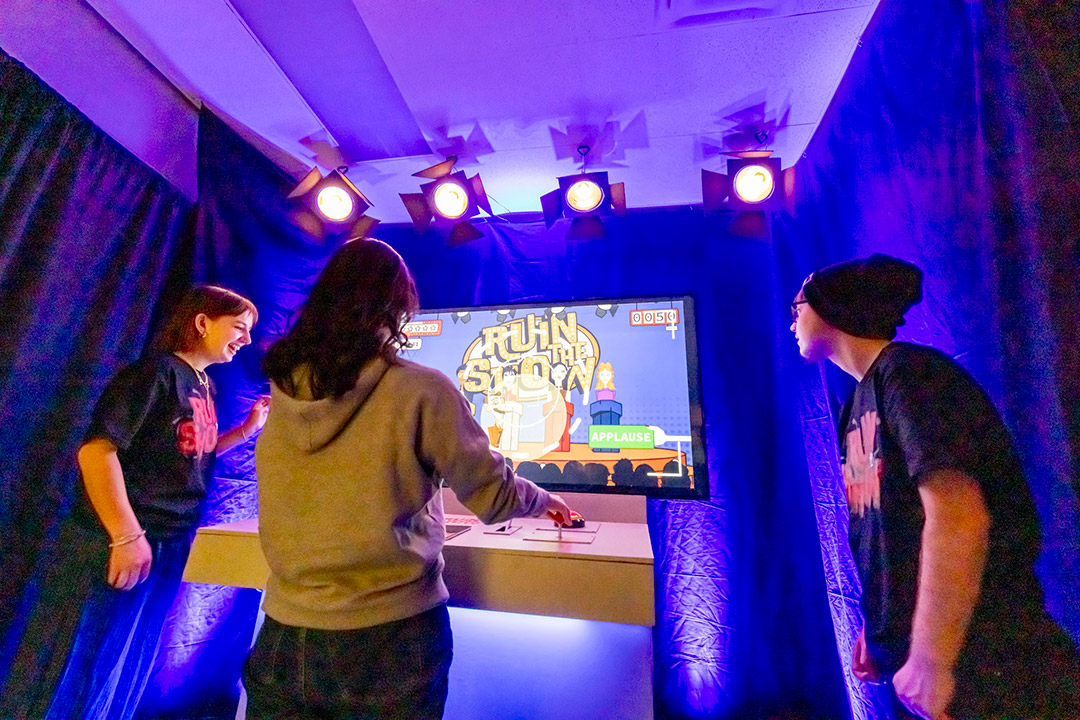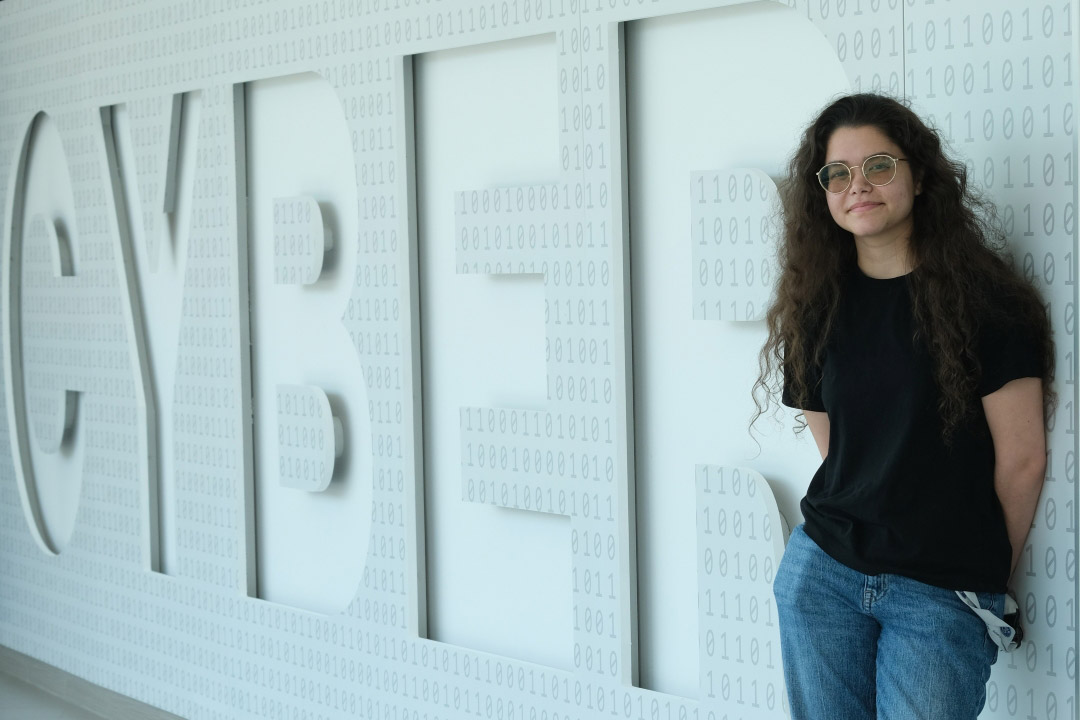Eleven questions with RIT’s 11th president
William H. Sanders was named RIT’s 11th president. He was introduced to the community on Jan. 28.
Sanders is currently dean of Carnegie Mellon University’s College of Engineering. He will assume RIT’s top post July 1, succeeding David Munson who will retire after serving eight years as RIT’s president.
Get to know RIT’s next president in this question and answer with Sanders.
1. What do you enjoy doing outside of work?
I enjoy outdoor activities, including hiking, kayaking, and canoeing. I also enjoy going to plays and getting together with friends to share home-cooked meals as well as going out to eat at local restaurants and listening to live music. I have also enjoyed photography as a hobby throughout my life.
2. We hear you enjoy amateur astronomy. Tell us how that began in your childhood?
I am a child of the Space Age, fascinated by the Apollo space program. When I was 12, I joined a class at the Grand Rapids, Michigan, public museum to build a 6-inch reflecting telescope, grinding the mirror for it by hand. That sparked my interest in space and astronomy further, and I joined and became active in the local amateur astronomy club. The club had an observatory (JC Veen Observatory), where I spent most clear nights as a teenager. This led to an interest in photometric photometry, doing observations for a professor at Vanderbilt University, and eventually working during summers when I was an undergraduate at Optec Inc., where I helped design the SSP-3 solid-state photometer.
3. What’s a favorite childhood memory?
Spending time at my family cabin in northern Michigan. My grandmother and grandfather built the cabin in 1937, and I would spend several weekends and a couple weeks there each summer. We did all the things you would expect—walking in and exploring the woods, hiking, swimming, boating, fishing, and spending quality time with my grandparents and family.
4. Tell us about your family?

Traci Westcott
Sanders and his wife, Emily, pose with Ritchie before the community announcement.
My wife, Emily, who studied French and art history at Michigan State University, made our family her career, supporting me and our children in innumerable ways. She enjoys art, gourmet cooking, travel, knitting, and hiking. Our daughter, Elizabeth, recently received her Ph.D. in engineering education from Purdue and is now a postdoc at the University of Illinois at Chicago. Our son, Zach, has a master’s degree in biomedical engineering from Purdue and is an R&D engineer at Cardinal Health in St. Louis. Both enjoy playing musical instruments in their spare time.
5. Do you have any pets?
We have a very energetic 4-year-old Labradoodle named Ollie.
6. What was your first job?
My first job was during high school, working at a dry cleaner, first as a janitor and doing odd jobs and later as a presser. I also worked occasionally at the local planetarium, running the shows.
7. If you have time, what have you been watching lately?
We just saw A Complete Unknown in a movie theater and really enjoyed it. I don’t watch much TV, but I like watching Michigan and other Big Ten college football games and various shows on PBS.
8. What are you reading?
I enjoy reading The New York Times, The Wall Street Journal, and The New Yorker. I always have a stack of books on my nightstand but don’t have a lot of time to read them.
9. What are you listening to or what’s on your playlist?
I mostly listen to jazz, some classical and folk, but enjoy other genres as well. I’m a fan of Susan Werner and Bruce Springsteen, especially his Broadway show, Springsteen on Broadway.
10. What is one thing people would be surprised to find out about you?
People are surprised to know that as a teenager I owned a “muscle car,” a 1971 Mercury Cougar with a 351 Cleveland engine.
11. What excites you about moving to the Greater Rochester area?
Obviously, joining the RIT community excites me the most, but I am also excited by the thrill of discovering Rochester and the surrounding region: exploring the Finger Lakes, eating at local restaurants, and meeting new people.

Traci Westcott
Sanders spoke with members of the RIT community, including graduate student Colin Farmer, at his introduction. He begins his tenure as RIT’s 11th president on July 1.
Latest All News
- Student-led NASA project takes flight on balloon missionA years-long student-led NASA project that develops technology to help guide rockets will near its final destination this month on board the Balloon Optimization Opportunity Platform!, or BOOP! Provided The BOOP! mission logo Astrophysical sciences and technology Ph.D. student Kazuma Noda has taken the lead and traveled to New Mexico for the launch of the balloon mission, which will take the Cryogenic Star Tracking Attitude Regulation System (CSTARS) into the atmosphere. Past RIT undergraduate students used NASA funding to create CSTARS, an instrument designed and built to orient a rocket payload based on the images of stars. CSTARS previously flew on the sounding rocket named the Cosmic Infrared Background ExpeRiment-2 (CIBER-2), but firmware issues hampered the mission. BOOP! will provide advantages to see CSTARS get the results many RIT students have worked towards. “I think we fixed the issue we had, and now we want to see if this can track stars again,” said Noda, who added that balloons are much cheaper than sounding rockets, and observation time will increase from 8 to 10 minutes to possibly four hours with BOOP! Associate Professor Michael Zemcov from the School of Physics and Astronomy and Professor Dorin Patru from Kate Gleason College of Engineering have been the lead advisers on the CSTARS effort, and are excited to see BOOP! take it to the finish line. “All these algorithms and systems and electronics that we’ve built over the almost ten years in support of CSTARS, we’re finally at the point where it all works,” he said. “This is a fun project that has a long history that many students have contributed to over the years.” As an undergraduate student in Japan, Noda worked with sounding rockets in collaboration with CIBER. He knew he wanted to continue doing the work, so he made the move to RIT for graduate school. While Zemcov corresponded with NASA to get CSTARS involved with the BOOP! mission, he handed the project to Noda to lead. “For a Ph.D. student, the ideal situation is to be given a leadership role,” said Zemcov. “He’s done really well in executing that. We should be giving students these opportunities as much as we possibly can. It’s the best way to learn.” Noda previously traveled to NASA’s Wallops Flight Facility in Virginia to integrate CSTARS onto the BOOP! gondola, and traveled to New Mexico for BOOP!’s launch, giving him hands-on, real-world experience with a NASA mission. As Zemcov added, “There’s no substitute for going out and doing it yourself.”
- Goodbye, Goodbuy! builds a decade of sustainability habitsA pink-and-green upholstered couch with wood accents made its third appearance at this year’s Goodbye, Goodbuy! sale. It’s not that it has been unwanted and waiting for a home. On the contrary. It’s been donated, sold, redonated, and resold three times. The couch is a testament to the sustainability efforts of the student-led Goodbye, Goodbuy! program, which for 10 years now has accepted donations from students moving out of residence halls and apartments at RIT each spring. Items are sorted and stored until new students move in for the fall semester, when they are sold at thrift store prices. Any unsold items are donated to Goodwill. “I definitely think we’ve made an impact with students,” said this year’s program director, Spencer Griebel, a fifth-year cybersecurity and computer information technologies double major from Webster, N.Y. “Even after the main collection in the spring had ended, I got emails from students wanting to donate things. Students are thinking about the program. It not only makes it easier for them to move out, it benefits the environment.” Traci Westcott/RIT From left, first-year students Autumn Clarke, Jordan Igel, and Kelly Yang check out Goodbye, Goodbuy! on Aug. 19 at the Gene Polisseni Center. This year, Griebel said more than 22,000 pounds of donations were collected, and that doesn’t include two tractor-trailers filled with furniture. This circular process offers a multitude of benefits: saving items from entering landfills; reducing carbon emissions; helping reduce costs to haul away trash for RIT; and helping students get items at low costs. The money generated from the sale is used to offset some of the costs to run the program. This spring, 14 student captains worked during collection, in addition to 200 volunteers. This year’s sale had 11 student captains and more than 100 volunteers. Volunteers also included RIT employees and staff from other area colleges who wanted to see how the program is run so that they may start their own. Volunteers are invited to a presale or can use a $5 certificate to use during the sale. Almost everything can be collected. Items this year included a ukulele, a gold-plated chain and pendant, designer clothing that still had its tags on, interesting sculptures and other art projects, an industrial coffee machine, and electronics including laptops, headphones, and televisions, which are tested to make sure they work. Electronics that don’t work are disposed of at proper e-waste sites. RIT departments have embraced the mission of the program as well. Tables being replaced from the Gene Polisseni Center were donated this year. Furniture, hangers, and racks were donated when Barnes & Nobles closed, kitchenware was donated from Henry’s restaurant, RIT Housing donates furniture they are replacing and other departments that are cleaning or moving regularly contribute as well. “We really appreciate everyone’s mindfulness and dedication. RIT is proud of what Goodbye, Goodbuy! has become, and it is our amazing students and many campus partners who make it a success every year,” said Enid Cardinal, senior advisor to the president for strategic planning and sustainability. “It’s one of our most visible sustainable initiatives.” Alden Smith, a 2024 finance graduate who had an immersion in environmental studies, worked for the program in her freshman year and served as its director a year later. “I got involved because I was very passionate about environmental sustainability and was trying to find an intersection between business and sustainability, finding ways businesses can be more environmentally conscious,” she said. “It was a fantastic experience. There were so many students who were absolutely shocked to find out how much they were able to save from landfills. That prompted students to think about the impact they have when they are buying things. It’s a really great learning opportunity.” Nick Giordano ’16 (management information systems) was the program’s first director in 2015. He returned to campus this year to volunteer several days with the collection and sale. He still uses the dresser he purchased from the sale that first year and is pleased to see so many more students involved as volunteers and in paid leadership roles. “I think it was impressive that the program has persisted for 10 years and matured so much,” he said. “It’s become an annual tradition and certainly brings sustainability to the forefront of campus.” As a college student on a budget, Griebel says he recycles and aspires to buy things second-hand when possible. But it’s more than just to save money. “Participating in Goodbye, Goodbuy! is a very easy way to start implementing sustainability in your everyday life,” he said. “It shows you ways to decrease your footprint and think about sustainability and ways to reduce waste while saving money. I’m pretty proud the program is still running and done so well after 10 years.”
- RIT cited as a top university for career outcomes by The Princeton ReviewRochester Institute of Technology once again made The Princeton Review “Best Colleges” list, recognized for its career outcomes for its students and superior game design programs in the Best 391 Colleges 2026 edition. Although specific rankings are not assigned in many categories, RIT does rank No. 6 for its undergraduate game design and development programs. Among other categories RIT was highly ranked: “Best Northeast” (a separate ranking by region and for colleges considered academically outstanding); “Colleges that Create Futures” (colleges that empower students to discover practical applications for their talents and interests through experiences that complement classes and coursework); and “Green Colleges” (colleges that emphasize sustainability in practice). This year’s profile details information about RIT’s co-op program—one of the country’s oldest and largest programs that regularly turns out career-ready students. The university culture was praised by students: “This is where students are able to create what their minds generate. It’s like a teenager’s dream” and “RIT has a culture for everybody.” Since 1992, the guide highlights the best in undergraduate academics. It features only about 15 percent of all U.S. four-year colleges and universities and uses survey information and comments from students to assess rankings with a focus on categories important to prospective students and families. The range of comments and high marks were in categories from campus life and academic programs to admissions and financial aid. The Princeton Review is one of several national and international rankings received by RIT.
- Student incubator provides space for aspiring entrepreneursZevez Zalay, a third-year finance and marketing student, has long been fascinated with the idea of community. After spending a day searching for a local spoken-word poetry group in Rochester, Zalay worked to envision a platform that offers a different experience. Zalay and their business partner, third-year software engineering student Nathan Jackson, are the creators of GroupSoup, a social engagement platform that brings people together for recurring meetups hosted at local businesses. The goal is to foster organic, authentic community building while helping small businesses increase foot traffic and gain customer insights. Pete Schuck/RIT From left, Nathan Jackson and Zevez Zalay present GroupSoup, a marketplace platform that helps drive foot traffic to local businesses, during Demo Night of the Bernard Kozel StartUP Program @ Saunders. “There’s no convenient catalog for people looking to organize meetups unless you’re willing to cold message businesses on Facebook or send out emails, which is a tedious process,” Zalay said. “We want to connect people who want to build community with businesses that want to bring people through the door.” The Bernard Kozel StartUP Program @ Saunders is helping student teams like GroupSoup turn innovative ideas into the beginnings of tangible businesses. As the program concludes its first cohort as a newly established program under the Saunders College of Business, named in honor of Bernard Kozel – well respected for his roles as a businessman and entrepreneur, innovator, investor, and connector. Eight student-led companies are reaping the rewards of a unique support system designed to help them thrive. Pathways for student entrepreneurship are not new to RIT. This program was originally founded in 2011 by professor Richard DeMartino and the late Rich Notargiacomo, former director of RIT’s Venture Creations business incubator, and later run by director Anthony Testa and Evan Vershay under the RIT Student Accelerator name until its rebranding in early 2025. In all, 167 teams and 479 students have participated across the last 23 cohorts. The effort is made possible by many benefactors, including support from the Bernard Kozel Endowed Fund for Innovation and Entrepreneurship. The program, open to all RIT students, is a 12-week immersive summer experience, offering guidance, hands-on learning, and networking opportunities for the student teams. The teams invest into their projects full-time and are given an honorarium to help build their ideas and meet at least twice a week as a group. They have alternative sessions with coaches, who have decades of business experience, and guest speakers from the world of business and leadership. The program culminates with Demo Night, where the teams showcase their business ideas in front of friends, family, and potential investors. One such venture is Endo Automation, which was supported through the Sarah Ramsey Strong Fund, and founded by graduate software engineering students Devaj Mody and Shridhar Vilas Shinde, and Lex Baker, a second-year computer science major. Their solution to a critical modern farming issue: a low-cost, AI-enabled drip irrigation system that uses soil moisture and rainfall sensors to optimize water usage. “We noticed the issues with farmers across the board, especially those in more arid regions in India and the United States,” said Mody. “Water shortages, loss of crops, and the expense to run a farm are all barriers for them. We basically decided to design a system that's able to carry out irrigation at a fraction of the cost, with all the benefits that the farmer would have.” The Endo Automation team designed and perfected their system in Rochester over the summer. The product is already gaining traction. The team has planned deployments this month at four farms in India, including a large vineyard. They’re also eyeing applications to World Bank initiatives for agricultural innovation. Provided The 23rd cohort of the Bernard Kozel StartUP Program @ Saunders was led by program director Anthony Testa, front, second from right, along with support by, from front left, coaches Steve Brookstein and Richard Condon, the 2025 Bernard Kozel Mentor of the Year. Along with GroupSoup and Endo Automation, this summer’s teams included: CYPER, an affordable cybersecurity assessment platform for small-to-medium businesses; ModuCore, a company which creates personalized organizers geared toward lifestyle artisans; Bone Bros, a semi-custom shoe brand bridging the gap between modern footwear and foot health; CollegeGO, an affordable one-stop shop for students and parents to simplify the college application experience; OpenSeek, an education and employment platform for early career UX designers; and Obscura, a breakthrough technology which prevents AI theft of art. A major addition to this summer’s format was the introduction of co-op students, provided with support from Saunders College, who were embedded into the startup teams. “That was a great experience,” said Baker. “It was a different look into managing others who may not have a stake or equity in the company like the three of us. We had to learn how to manage those different expectations, which was great to learn.” “The co-ops added a new dynamic,” added Testa. “Integrating any group of people into a process is not without hard work. The Kozel teams are learning entrepreneurship, but they're also learning how to be leaders and managers on the fly, which is really cool in this safe space.” Throughout the 12 weeks, the teams also formed a tight-knit community. They supported each other regularly through impromptu design feedback and help troubleshooting customer discovery hurdles. One example is through the OpenSeek team, who helped teams like Endo Automation with UI/UX work. A shared Discord group allowed the students to stay connected and share resources in real-time. “This was definitely one of the more connected groups we have had,” added Vershay. It's always encouraged by Anthony and me, but at the end of the day it's on them to really make it happen and connect with each other. They were great about that this year.” The 2025 cohort marked a turning point for the program. It drew a record number of applicants—24 in total—allowing staff to accept the most committed and promising eight groups. “We had alumni and long-time supporters telling us this was the strongest cohort they’d ever seen,” Testa said. “These students came ready.” Applications for the 24th cohort in the summer of 2026 are open on a rolling basis. Interested student teams are encouraged to apply early and reach out for guidance.
- Cybersecurity student Emery Rios awarded Norman Miles academic excellence awardWhen cybersecurity student Emery Rios got an email about winning an RIT award, they immediately thought it was suspicious. Luckily, after a bit of investigation, Rios was able to confirm that the email was not a phishing attack. Rios, a combined accelerated cybersecurity BS/MS student, was selected for the Norman A. Miles Award for Academic Excellence in Study for the 2025-2026 academic year. The award is given to a student who began their studies as a first-year student at RIT and is entering their final year of undergraduate study with the highest grade point average across the university. Recommendations from deans are also considered. Provided Yin Pan, professor in the Department of Cybersecurity, was selected by Emery Rios for the Norman A. Miles Award for Academic Excellence in Teaching. A second component of the award allows the student to recognize a faculty member who contributed to their success at RIT. Rios selected Yin Pan, professor in the Department of Cybersecurity, for the Norman A. Miles Award for Academic Excellence in Teaching. “Professor Pan is so caring, understanding, and truly wants students to succeed,” said Rios. “She is really deserving of this award for the impact she has made on every student, not just me.” Rios chose to attend RIT after finding a love for cybersecurity through a special program in high school. They were also a big fan of Penelope Garcia, the technical analyst on the TV show Criminal Minds. “Digital forensics can be like a crime scene investigation, but doing it on a device,” said Rios, who is from Waldorf, Md. At RIT, Rios enjoyed taking a class in social engineering—where they got to complete a tailgating assessment—and working on a USB baiting attack field experiment that was later published at a cybersecurity conference. As a third-year, Rios took an advanced computer forensics course with Pan. “Emery stood out right away, always asking insightful questions and an enthusiasm to learn new things,” said Pan. For a group project in Pan’s class, Rios worked on a forensic analysis for open source cloud technology. They completed an overview of existing tools, identified limitations, and studied how to modify tools to fit in cloud forensics. “I gave them a 100,” said Pan. “That is very unusual, but I couldn’t pick out anything unsatisfactory.” Rios has since become a teaching assistant (TA) for two of Pan’s computer forensics courses. As a TA, they grade assignments and host open office hours to help other students with technical questions. During the summer, Rios did a cybersecurity co-op with Dick’s Sporting Goods, at the Security Operations Center near Pittsburgh. Outside of class, Rios enjoys being a Resident Advisor and was a Performing Arts Scholar for acting. They are also president of RIT Cosplay Troupe, which meets weekly and holds events and performances throughout the year. Rios is known for cosplaying Dungeons & Dragons characters. As part of the Norman Miles award, Rios is earning a scholarship and Pan will receive funds to support faculty professional development activities. Pan plans to use the money to attend an interesting conference or to support research. She hopes to get a laptop for students who are interested in studying how features in the newest Microsoft Windows system impact forensic analysis.
- Ph.D. student’s NASA-funded research leads to new insight on exoplanetsLike many Ph.D. students, Attila Varga’s professional pursuits include being a lead author on a published paper. But, getting his research featured on the front page of NASA’s website and in news outlets around the world is definitely a bonus. Varga, an astrophysical sciences and technology Ph.D. candidate at RIT, is proud of his research that has led to new understanding about a newborn exoplanet that is shrinking due to the harsh X-rays of its nearby host star. Named TOI 1227 b, the planet is the second youngest ever to be observed passing in front of its host star. While previous estimations put the planet’s age at 11 million years, Varga’s study found the planet to be 8 million years old, which is very young by planetary standards (by comparison, the Earth is about 5 billion years old). The team’s research on TOI 1227 b began when Varga noticed that one of the young stars he had been studying, named TOI 1227, had been identified as a potential exoplanet host by a separate NASA mission. After the exoplanet was confirmed, the research team, led by Varga and his dissertation adviser Joel Kastner, professor in the School of Physics and Astronomy and Chester F. Carlson Center for Imaging Science, used NASA’s Chandra X-Ray Observatory to measure the star’s intense high-energy radiation. Varga then led a series of computer models that demonstrated that the effects of this intense stellar X-ray bombardment of the planet was probably devastating. TOI 1227 b’s atmosphere is being blasted away and its mass is due to shrink. “It’s almost unfathomable to imagine what is happening to this planet,” said Varga. “The planet’s atmosphere simply cannot withstand the high X-ray dose it’s receiving from its star.” Varga’s work on the effects of young star X-rays on their newborn planets will continue as he, fellow astrophysical sciences and technology Ph.D. student Ryan Butler, and adviser Kastner were recently awarded Chandra observing time to measure X-ray radiation from another exoplanet host star that is even younger than TOI 1227. “When Attila told me that he had found an exoplanet host among the hundreds of young stars he had been studying, I have to say my jaw kind of dropped on the floor because it was such a significant discovery,” said Kastner. “You can learn a lot by looking at these very young planets to determine how our solar system came to be and if there are other solar systems like ours.” Along with Varga and Kastner, other collaborators on the paper published in The Astrophysical Journal include Alexander Binks from Eberhard Karls University of Tubingen in Germany, Moritz Guenther from Massachusetts Institute of Technology, and Simon Murphy from The University of New South Wales in Australia. The opportunity to work with researchers around the world and to have direct access to NASA telescopes like Chandra was what helped bring Varga to RIT. “I really like the research when the focus is X-ray astronomy,” said Varga. “It was really cool that we could propose time with Chandra and get the data back, and have such definite measurement of this young exoplanet host star’s X-ray radiation. It’s exciting, and it puts all the work in my classes and experience I’ve been getting together really nicely.” For Kastner, supervising a Ph.D. student making such discoveries is just as rewarding. “Seeing him get to the place where he’s making major advances in exoplanet research with data collected from a major international observatory is wonderful,” said Kastner. “Even better, he’s done so by taking the research initiative and leading an international team of recognized experts in the field.”













